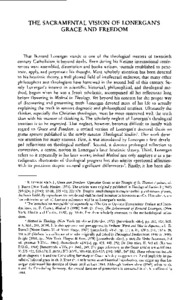Por favor, use este identificador para citar o enlazar este ítem:
https://repositorio.uca.edu.ar/handle/123456789/12955| Campo DC | Valor | Lengua/Idioma |
|---|---|---|
| dc.contributor.author | McDermott, John M. | es |
| dc.date.accessioned | 2021-11-19T10:43:35Z | - |
| dc.date.available | 2021-11-19T10:43:35Z | - |
| dc.date.issued | 1995 | - |
| dc.identifier.citation | McDermott, J. M. The sacramental vision of Lonergan's Grace and freedom [en línea]. Sapientia. 1995, 50 (195-196). Disponible en: https://repositorio.uca.edu.ar/handle/123456789/12955 | es |
| dc.identifier.issn | 0036-4703 | - |
| dc.identifier.uri | https://repositorio.uca.edu.ar/handle/123456789/12955 | - |
| dc.description.abstract | Resumen: That Bernard Lonergan stands as one of the theological masters of twentieth century Catholicism is beyond doubt. Even during his lifetime internacional conferences were assembled, dissertation and books written, joumals established to penetrate, apply, and perpetuate his thought: Most scholarly attention has been directed to his heuristic theory, a well plowed field of intellectual endeavor, that many other philosophers and theologians have harrowed in the second half of this century. Surely Lonergan' s interest in scientific, historical, philosophical, and theological method, begun when he was a Jesuit scholastic, accompanied all his reflections long before flowering in Method in Theology. Yet beyond his concern for the proper way of discovering and presenting truth Lonergan devoted most of his life to actually explaining the truth in various dogmatic and philosophical treatises. Ultimately the thinker, especially the Christian theologian, must be more concerned with the truth than with his manner of thinking it. The scholarly neglect of Lonergan's theological treatises is to be regretted. That neglect, however, becomes difficult to justify with regard to Grace and Freedom, a revised version of Lonergan's doctoral thesis on gratia operans published in the newly nascent Theological Studiesl. This work deserves attention for many reasons. First, it was introduced by Lonergan's first developed reflections on theological method2. Second, it devotes prolonged reflection to conversion, a central notion in Lonergan's later heuristic theory. Third, Lonergan refers to it repeatedly in his later works; indeed Method not only employs it as a paradigmatic illustration of theological progress but also admits «profound affinities» with its positions despite «severa! significant differences». | es |
| dc.format | application/pdf | es |
| dc.language.iso | eng | es |
| dc.publisher | Pontificia Universidad Católica Argentina. Facultad de Filosofía y Letras | es |
| dc.rights | Acceso abierto | * |
| dc.rights.uri | http://creativecommons.org/licenses/by-nc-sa/4.0/ | * |
| dc.source | Sapientia. 1995, 50 (195-196) | es |
| dc.subject | Lonergan, Bernard J. F., S.I., 1904-1984 | es |
| dc.subject | GRACIA | es |
| dc.subject | LIBERTAD | es |
| dc.subject | TEOLOGIA | es |
| dc.subject | CATECISMO | es |
| dc.subject | FILOSOFIA | es |
| dc.subject | HEURISTICA | es |
| dc.subject | Gracia y libertad | es |
| dc.title | The sacramental vision of Lonergan's Grace and freedom | es |
| dc.type | Artículo | es |
| uca.disciplina | FILOSOFIA | es |
| uca.issnrd | 1 | es |
| uca.affiliation | Fil: McDermott, John M. Pontificia Universidad Gregoriana; Italia | es |
| uca.version | publishedVersion | es |
| item.fulltext | With Fulltext | - |
| item.grantfulltext | open | - |
| item.languageiso639-1 | en | - |
| Aparece en las colecciones: | SAP - 1995 Vol L nro. 195-196 | |
Ficheros en este ítem:
| Fichero | Descripción | Tamaño | Formato | |
|---|---|---|---|---|
| sacramental-vision-lonergans.pdf | 537,62 kB | Adobe PDF |  Visualizar/Abrir |
Visualizaciones de página(s)
44
comprobado en 27-abr-2024
Descarga(s)
211
comprobado en 27-abr-2024
Google ScholarTM
Ver en Google Scholar
Este ítem está sujeto a una Licencia Creative Commons

